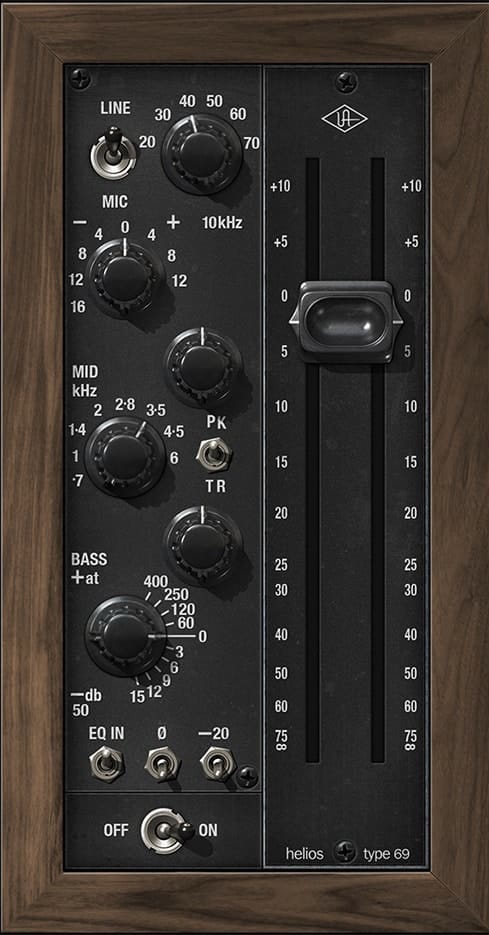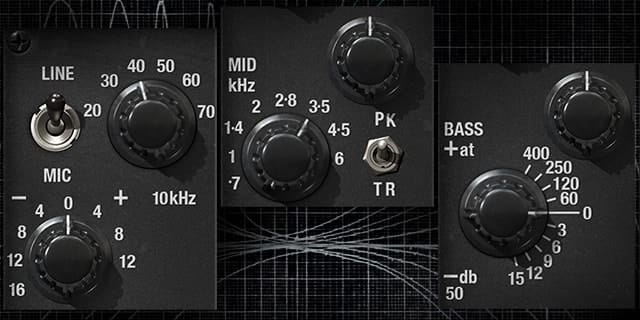New Software Review: Helios Type 69 Preamp and EQ Collection by Universal Audio
The Helios console is one of the most well-regarded pieces of equipment in the history of recorded music.
Originally designed and built in 1969 by Dick Swettenham of Olympic Studios to equip the new Island Records, these consoles have been used on countless recordings. Richard Branson’s early Virgin Records employed several, The Rolling Stones’ famed mobile recording unit had one, as did the Beatles’ Apple Studios.
Universal Audio, in its quest to model so many of the most-lauded items from our shared recording history, is now offering a ground-up new emulation of the Helios Type 69 Preamp and EQ Collection. Let’s take a closer look.
Features
The Helios Type 69 Preamp and EQ Collection consists of two pieces of software: The new, fully remodeled preamp and EQ, as well as the Legacy Type 69 EQ introduced originally by UAD in 2006, which was one of UA’s earlier forays into vintage gear emulation. However, the new version is an update in terms of looks and functionality. More specifically, the Legacy version is just the EQ, whereas the newer version is more or less modeled after an entire channel strip on one of the famed consoles.
Both versions of the software model the unique layout and design of the popular Helios EQ. The low band works in two ways. It offers a bell-shaped boost at one of four specific frequencies (60, 120, 250, and 400 Hz on the new model; 60, 100, 200, and 300 Hz on the Legacy EQ). Even when the low gain is set to zero, there is a small bass boost if the frequency selector is not on zero itself. The alternate use of the low band is as a bass cut, selectable at either -3, -6, -9, -12, or -15 dB down at 50 Hz. Both circuits cannot be used at the same time; it’s one or the other, meaning the gain knob has no affect when the controls are set to the bass cut filter.
Up next is the mid band of the EQ, with points at .7, 1, 1.4, 2, 2.8, 3.5, 4.5, and 6 kHz on both the new and Legacy versions. The mid gain can be set to PK or TR (peak or trough… how very British), meaning boost or cut. Like the hardware itself, the units offer up to 15 dB of gain, or 9.9 dB of attenuation. The bandwidth is wide, but narrows as gain is increased. This is sometimes referred to as progressive Q, or proportional Q.
Lastly for the EQ, we come to the high shelf. The new model offers up to 12 dB boost or -16 dB cut in 4 dB increments. The Legacy version can cut by either -3 or -6 dB, or offers up to 16 dB boost in 2 dB increments. The EQ points on the two are different even though they are both of the “Type 69” variant. At the time, consoles like this were never “off the rack” so to speak, and were custom made for each studio. The legacy version is based off the EQ from the Basing Street models, while the newer Unison version emulates the earlier Olympic Studio type with the Lustraphone transformers.
This is where the units start to diverge. The Legacy model has an output level adjustment (to counteract heavy boosts in the EQ) and a power switch (oddly labeled “LINE”; on the Legacy version there is no mic input, so it’s used here as a hard bypass). However, the new emulation also models the venerable Helios Preamp using UA’s Unison technology (more on that later). The preamp controls here offer selectable gain, allowing for 20, 30, 40, 50, 60, and 70 dB. If you wish to really drive the input, or boost heavily with the EQ, there is also a fader which allows you to adjust output level without changing the tone in any way.![]()
The preamp allows you to pad the input by -20 dB, reverse the polarity, and also engage/disengage the equalizer circuit. Another very nice feature is the ability to choose either a mic or line input. This is designed to offer tonal distortion choices as it mimics a line signal going through the mic amp… just like you can on the real hardware.
Earlier I mentioned Unison technology, and I want to touch on it here and the related UA hardware controls, as the hardware and software interact crucially. And not just in tone, but in usability as well.
Part of what gives any piece of gear its sound is the impedance. And when two pieces of gear connect, the output impedance of one interacts with the input impedance of the next piece in the chain. It’s a complex reaction, and changes to the impedance absolutely affect the sound. Part of the reason the Universal Audio preamps have been able to so accurately mimic classic preamps (and guitar and bass amps as well) is that the hardware can change its input impedance to match the item being emulated. Thus, any given mic will interact the exact same way it would with the actual hardware. Additionally, the gain and level adjustments for this preamp can be made from the hardware itself, which is a nice touch and makes it feel that much more like you are working with the real deal.
In Use
Over the past few months, I have used the Helios Type 69 Preamp and EQ Collection on a variety of sources recorded in different places. I must confess that I love it. Whether on electric guitars, vocals, drums, or percussion, this preamp has become my go-to model when tracking; I love its mid-forward characteristic. There is a certain classic grit that jumps forward and feels thick and assertive. It doesn’t have the huge, clear bottom or top of some more modern models, however there is a whole usable range of tones from clean and realistic, to over-driven and nasty. I really like the way this preamp breaks up, even if there is a whole range that is further than I would ever go.
Switching between the mic and line input, as well as using the pad and the output fader, allowed me to hit the sweet spot with most input signals, and also made it easy to get varying amounts of distortion when needed. It performed well whether I was using moving coil, ribbon, or condenser mics, and I even really liked the sound of keys and bass tracked using the Hi-Z input. If I were working more on Jazz or Classical, or even modern Pop that needs a more scooped mid/hyped high and low tone, I probably wouldn’t use this preamp. However, in the indie and rock world that I have been working in, the sound of this preamp has helped make recording and mixing more fun, and the artists have loved the end result as well.
To my ears, the new emulation sounds much more three-dimensional and vibrant than the Legacy version, although it’s nice to have the older model for when you need a dash of that character but are running light on CPU.
The last page of the manual gives a partial list of records recorded on Helios consoles, and it reads exactly like this emulation sounds. The Type 69 Preamp is the sound of the late 60’s into the 70’s. From Black Sabbath to the Stones, and from Bob Marley to Donna Summer, this emulation captures those classic sounds and vibes.
To Be Critical
It should be said though, this is not an everyday utilitarian tool; it’s got a very enigmatic and strange EQ circuit. I know of nothing else like it. The EQ is great for adding a specific type of character and color, but as a problem solver, it is extremely limited in scope.
Additionally, I often found the 10 dB jumps in gain larger than I would like. Sometimes I wanted just a bit more gain and crunch, and a smaller jump (say 5 dB increments) would have been much more useful. That being said, it’s hard to critique an emulation of some (for all intents and purposes) ancient technology. The goal here was clearly not to make the most practical “everyday” preamp, but instead to capture a little of that non-linear magic from days past.
Summing it Up
Some may question why another Helios emulation was made (and has to be paid for) when one model already existed. In comparing the two models, the newer version has a depth and texture missing from the old. Modeling technology has come a long way in those years.
According to Universal Audio, this is a much more thorough and accurate rendition of the circuitry. Priced at $299, the Helios Type 69 Preamp and EQ Collection may not necessarily be for everyone. However, for those seeking a little of that vintage tone, this new model might be exactly what they are looking for.
Please note: When you buy products through links on this page, we may earn an affiliate commission.









[…] Originally designed and built in 1969 by Dick Swettenham of Olympic Studios to equip the new Island Records, these consoles have been used on countless recordings. Richard Branson’s early Virgin Records employed Read more… […]